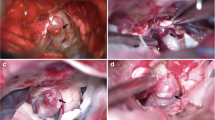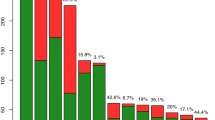Abstract
Presurgical discrimination of blood blister-like aneurysms (BBAs) can assist neurosurgeons in clinical decision-making. The aim of this study was to investigate the characteristics of BBAs and construct a useful tool to distinguish BBAs. This study reviewed patients with small/median, hemispherical, and wide-necked aneurysms of the internal carotid artery in our institution. BBAs were identified via their intraoperative findings. A hemodynamic analysis was performed using a patient-specific model. The independent risk factors of BBAs were investigated using a logistic analysis. A scoring system was then established to discriminate BBAs, in which its predicting value was analyzed using receiver operating characteristic (ROC) analysis. A total of 67 aneurysms comprising 21 BBAs were enrolled. Comparing features between BBAs and non-BBAs, statistical significances were found in the aspect ratio (AR), height-to-width ratio, aneurysm angle (AA), wall shear stress gradient (WSSG), and normalized wall shear stress average. A multivariate logistic analysis identified AR (OR = 0.29, p = 0.021), WSSG (OR = 1.54, p = 0.017) and AA (OR = 2.49, p = 0.039) as independent risk factors for BBAs. A scoring system was constructed using these parameters, effectively distinguishing BBAs (AUC = 0.931, p < 0.01). Our multidimensional scoring system may effectively assist in the discrimination of BBAs from wide-necked non-BBAs.




Similar content being viewed by others
Data availability
Not applicable
References
Abe M, Tabuchi K, Yokoyama H, Uchino A (1998) Blood blisterlike aneurysms of the internal carotid artery. J Neurosurg 89:419–424. https://doi.org/10.3171/jns.1998.89.3.0419
Cho KH (2006) Blood blister–like aneurysms at nonbranching sites of the internal carotid artery. J Neurosurg 105:400–405
Nakagawa F, Kobayashi S, Takemae T, Sugita K (1986) Aneurysms protruding from the dorsal wall of the internal carotid artery. J Neurosurg 65:303–308. https://doi.org/10.3171/jns.1986.65.3.0303
Mitha AP, Spetzler RF (2010) Blister-like aneurysms: an enigma of cerebrovascular surgery. World Neurosurg 74:444–445. https://doi.org/10.1016/j.wneu.2010.10.006
Peterson EC (2017) Microsurgical versus endovascular interventions for blood-blister aneurysms of the internal carotid artery: systematic review of literature and meta-analysis on safety and efficacy. J Neurosurg:1–13
Kantelhardt SR, Archavlis E, Giese A (2016) Combined suture and clip** for the reconstruction of a ruptured blister-like aneurysm. Acta Neurochir 158:1907–1911. https://doi.org/10.1007/s00701-016-2919-9
Rouchaud A, Brinjikji W, Cloft HJ, Kallmes DF (2015) Endovascular treatment of ruptured blister-like aneurysms: a systematic review and meta-analysis with focus on deconstructive versus reconstructive and flow-diverter treatments. AJNR Am J Neuroradiol 36:2331–2339. https://doi.org/10.3174/ajnr.A4438
Nishikawa H, Shimizu S, Nakajima H, Kitano Y, Sano T, Mouri G, Miya F, Suzuki H (2017) Characteristics of blood blister-like aneurysms with a saccular-shape appearance. World Neurosurg 108:595–602. https://doi.org/10.1016/j.wneu.2017.09.054
Mizutani T, Kojima H (2000) Clinicopathological features of non-atherosclerotic cerebral arterial trunk aneurysms. Neuropathology 20:91–97. https://doi.org/10.1046/j.1440-1789.2000.00277.x
Tatsuya I, Nishio N, Kiyohiro H, Mikio N (1997) Pathological consideration of a “blister-like” aneurysm at the superior wall of the internal carotid artery: case report. Neurosurgery:2
Bojanowski MW, Weil AG, McLaughlin N, Chaalala C, Magro E, Fournier JY (2015) Morphological aspects of blister aneurysms and nuances for surgical treatment. J Neurosurg 123:1156–1165. https://doi.org/10.3171/2014.11.JNS141004
Regelsberger J, Matschke J, Grzyska U, Ries T, Fiehler J, Koppen J, Westphal M (2011) Blister-like aneurysms--a diagnostic and therapeutic challenge. Neurosurg Rev 34:409–416. https://doi.org/10.1007/s10143-011-0313-x
Zhao Y, Qian Z, Wang S, Dong Z, Yan Z, Zhao Y (2018) Comparison of radiological and clinical characteristics between blood blister-like aneurysms (BBAs) and non-blister aneurysms at the supraclinoid segment of internal carotid artery. Neurosurgical Review
Gaughen JR, Raghavan P, Jensen ME, Hasan D, Pfeffer AN, Evans AJ (2010) Utility of CT angiography in the identification and characterization of supraclinoid internal carotid artery blister aneurysms. AJNR Am J Neuroradiol 31:640–644
Otani N, Takasato Y, Masaoka H, Hayakawa T, Yoshino Y, Yatsushige H, Sumiyoshi K, Miyawaki H, Aoyagi C, Takeuchi S (2009) Clinical and radiological findings and surgical management of ruptured aneurysms at the non-branching sites of the internal carotid artery. J Clin Neurosci 16:1023
Dolan JM, Kolega J, Meng H (2013) High wall shear stress and spatial gradients in vascular pathology: a review. Ann Biomed Eng 41:1411–1427. https://doi.org/10.1007/s10439-012-0695-0
Meng H, Tutino VM, **ang J, Siddiqui A (2014) High WSS or low WSS? Complex interactions of hemodynamics with intracranial aneurysm initiation, growth, and rupture: toward a unifying hypothesis. AJNR Am J Neuroradiol 35:1254–1262. https://doi.org/10.3174/ajnr.A3558
Jiang P, Liu Q, Wu J, Chen X, Li M, Li Z, Yang S, Guo R, Gao B, Cao Y, Wang S (2018) A novel scoring system for rupture risk stratification of intracranial aneurysms: a hemodynamic and morphological study. Front Neurosci 12:596. https://doi.org/10.3389/fnins.2018.00596
Liu Q, Jiang P, Wu J, Gao B, Wang S (2019) The morphological and hemodynamic characteristics of the intraoperative ruptured aneurysm. Front Neurosci 13:233. https://doi.org/10.3389/fnins.2019.00233
Dhar S, Tremmel M, Mocco J, Kim M, Yamamoto J, Siddiqui AH, Hopkins LN, Meng H (2008) Morphology parameters for intracranial aneurysm rupture risk assessment. Neurosurgery 63:185–196; discussion 196-187. https://doi.org/10.1227/01.NEU.0000316847.64140.81
Tegeler CH, Crutchfield K, Katsnelson M, Kim J, Tang R, Passmore Griffin L, Rundek T, Evans G (2013) Transcranial Doppler velocities in a large, healthy population. J Neuroimaging 23:466–472. https://doi.org/10.1111/j.1552-6569.2012.00711.x
Tian Z, Zhang Y, **g L, Liu J, Zhang Y, Yang X (2016) Rupture risk assessment for mirror aneurysms with different outcomes in the same patient. Front Neurol 7:219. https://doi.org/10.3389/fneur.2016.00219
**ang J, Natarajan SK, Tremmel M, Ma D, Mocco J, Hopkins LN, Siddiqui AH, Levy EI, Meng H (2011) Hemodynamic-morphologic discriminants for intracranial aneurysm rupture. Stroke 42:144–152
Bacigaluppi S, Piccinelli M, Antiga L, Veneziani A, Passerini T, Rampini P, Zavanone M, Severi P, Tredici G, Zona G, Krings T, Boccardi E, Penco S, Fontanella M (2014) Factors affecting formation and rupture of intracranial saccular aneurysms. Neurosurg Rev 37:1–14. https://doi.org/10.1007/s10143-013-0501-y
Etminan N, Buchholz BA, Dreier R, Bruckner P, Torner JC, Steiger HJ, Hanggi D, Macdonald RL (2014) Cerebral aneurysms: formation, progression, and developmental chronology. Transl Stroke Res 5:167–173. https://doi.org/10.1007/s12975-013-0294-x
Frosen J, Tulamo R, Paetau A, Laaksamo E, Korja M, Laakso A, Niemela M, Hernesniemi J (2012) Saccular intracranial aneurysm: pathology and mechanisms. Acta Neuropathol 123:773–786. https://doi.org/10.1007/s00401-011-0939-3
Liaw N (2012) Basic science : the role of hemodynamics in intracranial aneurysm initiation. International Review of Thrombosis 7:1–14
Liu P, Song Y, Zhou Y, Liu Y, Qiu T, An Q, Song J, Li P, Shi Y, Li S, Quan K, Yang GY, Zhu W (2018) Cyclic mechanical stretch induced smooth muscle cell changes in cerebral aneurysm progress by reducing collagen type IV and collagen type VI levels. Cell Physiol Biochem 45:1051–1060. https://doi.org/10.1159/000487347
Signorelli F, Sela S, Gesualdo L, Chevrel S, Tollet F, Pailler-Mattei C, Tacconi L, Turjman F, Vacca A, Schul DB (2018) Hemodynamic stress, inflammation, and intracranial aneurysm development and rupture: a systematic review. World Neurosurg 115:234–244. https://doi.org/10.1016/j.wneu.2018.04.143
Day AL (1990) Aneurysms of the ophthalmic segment. A clinical and anatomical analysis. J Neurosurg 72:677–691. https://doi.org/10.3171/jns.1990.72.5.0677
Shojima M, Nemoto S, Morita A, Oshima M, Watanabe E, Saito N (2010) Role of shear stress in the blister formation of cerebral aneurysms. Neurosurgery 67:1268–1274; discussion 1274-1265. https://doi.org/10.1227/NEU.0b013e3181f2f442
Chiu JJ, Chien S (2011) Effects of disturbed flow on vascular endothelium: pathophysiological basis and clinical perspectives. Physiol Rev 91:327–387. https://doi.org/10.1152/physrev.00047.2009
Frösen J, Piippo A, Paetau A, Kangasniemi M, Niemelä M, Hernesniemi J, Jääskeläinen J (2004) Remodeling of saccular cerebral artery aneurysm wall is associated with rupture. Stroke 35:2287–2293
Koseki H, Miyata H, Shimo S, Ohno N, Mifune K, Shimano K, Yamamoto K, Nozaki K, Kasuya H, Narumiya S, Aoki T (2020) Two diverse hemodynamic forces, a mechanical stretch and a high wall shear stress, determine intracranial aneurysm formation. Transl Stroke Res 11:80–92. https://doi.org/10.1007/s12975-019-0690-y
Nobutaka H, Minoru M, Shuji F, Kentaro H, Kazuhiko S (2011) Detection of blood blister-like aneurysm and intramural hematoma with high-resolution magnetic resonance imaging. J Neurosurg
Haji FA, Boulton MR, de Ribaupierre S (2011) Blister-like supraclinoid internal carotid artery pseudoaneurysm in a 15-year-old male: case report and review of the literature. Pediatr Neurosurg 47:449–454. https://doi.org/10.1159/000339355
Balik V, Kourilova P, Sulla IJ, Vrbkova J, Srovnal J, Sulla I, Talari S (2020) Comparison of bypass and non-bypass surgical treatments for internal carotid artery blood blister-like aneurysms: a meta-analysis of efficacy, safety, and outcomes. World Neurosurg 144:283–292.e12. https://doi.org/10.1016/j.wneu.2020.08.089
Kazumata K, Nakayama N, Nakamura T, Kamiyama H, Terasaka S, Houkin K (2014) Changing treatment strategy from clip** to radial artery graft bypass and parent artery sacrifice in patients with ruptured blister-like internal carotid artery aneurysms. Neurosurgery 10(Suppl 1):66–72; discussion 73. https://doi.org/10.1227/NEU.0000000000000076
Liu Z, Zhang S, Wang S, Chen Q (2017) Management of blood blister-like aneurysms of the internal carotid artery: lessons learned from direct clip** in 22 cases. World Neurosurg 108:618–626. https://doi.org/10.1016/j.wneu.2017.09.080
Li W, Wang S, Tian Z, Zhu W, Zhang Y, Zhang Y, Wang Y, Wang K, Yang X, Liu J (2020) Discrimination of intracranial aneurysm rupture status: patient-specific inflow boundary may not be a must-have condition in hemodynamic simulations. Neuroradiology 62:1485–1495. https://doi.org/10.1007/s00234-020-02473-1
Kamijo K, Matsui T (2010) Acute extracranial-intracranial bypass using a radial artery graft along with trap** of a ruptured blood blister-like aneurysm of the internal carotid artery. Clinical article. J Neurosurg 113:781–785. https://doi.org/10.3171/2009.10.JNS09970
Funding
This study was supported by the “National Natural Science Foundation of China” (Grant No. 81671129 and 81471210) and “Major special projects in the 13th five-year plan” (Grant No.2016YFC1301800).
Author information
Authors and Affiliations
Contributions
Author contributions to the study and manuscript preparation include the following. Conception and design: SC and QL. Acquisition of data: QL, YY, PJ, and ML. Analysis and interpretation of data: QL, YY, and BG. Drafting the article: QL. Critically revising the article: JW and SW. Reviewing submitted version of manuscript: all authors. Approving the final version of the manuscript on behalf of all authors: SW. Administrative/technical/material support: BR, NW, YZ, and YC. Study supervision: SW.
Corresponding authors
Ethics declarations
Conflict of interest
The authors declare that they have no conflict of interest.
Code availability
Not applicable
Ethics approval
The work was approved by the Institutional Review Board of Tiantan Hospital (ky2019-096-02).
Informed consent
Written informed consent was obtained from their legally authorized representatives. Privacy of patient was effectively protected.
Additional information
Publisher’s note
Springer Nature remains neutral with regard to jurisdictional claims in published maps and institutional affiliations.
Rights and permissions
About this article
Cite this article
Chen, S., Liu, Q., Ren, B. et al. A scoring system to discriminate blood blister-like aneurysms: a multidimensional study using patient-specific model. Neurosurg Rev 44, 2735–2746 (2021). https://doi.org/10.1007/s10143-020-01465-2
Received:
Revised:
Accepted:
Published:
Issue Date:
DOI: https://doi.org/10.1007/s10143-020-01465-2




